|
|
|
Sort Order |
|
|
|
Items / Page
|
|
|
|
|
|
|
| Srl | Item |
| 1 |
ID:
132961
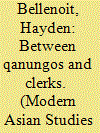

|
|
|
|
|
| Publication |
2014.
|
| Summary/Abstract |
This paper argues that our understanding of the transition to colonialism in South Asia can be enriched by examining the formation of revenue collection systems in north India between 1750 and 1850. It examines agrarian revenue systems not through the prism of legalism or landholding patterns, but by looking at the paper and record-based mechanisms by which wealth was actually extracted from India's hinterlands. It also examines the Kayastha pensmen who became an exponentially significant component of an Indo-Muslim revenue administration. They assisted the extension of Mughal revenue collection capabilities as qanungos (registrars) and patwaris (accountants). The intensity of revenue assessment, extraction and collection had increased by the mid 1700s, through the extension of cultivation and assessment by regional Indian kingdoms. The East India Company, in its agrarian revenue settlements in north India, utilized this extant revenue culture to push through savage revenue demands. These Kayastha pensmen thus furnished the 'young' Company with the crucial skills, physical records, and legitimacy to garner the agrarian wealth which would fund Britain's Indian empire. These more regular patterns of paper-oriented administration engendered a process of 'bureaucratization' and the emergence of the modern colonial state.
|
|
|
|
|
|
|
|
|
|
|
|
|
|
|
|
| 2 |
ID:
177791


|
|
|
|
|
| Summary/Abstract |
The presence of a curious Iranian in Bombay in 1801–1804 resulted in an unpublished extensive diary, a record containing much valuable data about urban development and business relations in this harbour city. The author’s daily commentary and precise notes, compiled over the first 3 years of the nineteenth century, constitutes an unusual archive from colonial times, providing information about Bombay and its Parsis, as well as the role of Persians in the economy and politics of India under the East India Company (EIC).
|
|
|
|
|
|
|
|
|
|
|
|
|
|
|
|
| 3 |
ID:
131459
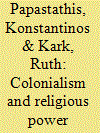

|
|
|
|
|
| Publication |
2014.
|
| Summary/Abstract |
This article critically assesses the conflict within the Orthodox Church of Jerusalem between the Greek hierarchy and the Arab laity concerning the proposals of the Mandatory Government for a new regulatory framework for patriarchal operation. The British presented two draft reform ordinances, neither of which met Arab expectations. Instead of promoting the laity's emancipation from 'foreign' Greek administrative and financial control, the ordinances left little room for a true inversion of the power structure between the two opposing camps, retaining the status quo at the expense of the Arab Orthodox rights.
|
|
|
|
|
|
|
|
|
|
|
|
|
|
|
|
| 4 |
ID:
184141
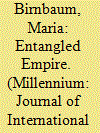

|
|
|
|
|
| Summary/Abstract |
In this article I trace the transnational history of Pakistan and Israel, focusing on the global politics of religion entailed therein. I study the often-overlooked intra-imperial dynamics and the ways in which these intersected with the colonial and post-colonial sociology of knowledge, the politics of cultural diversity and the changing international order. I illustrate how the census and the enumeration of minorities, the claim to political representation, and the transition from ‘minority’ to ‘nation’ shaped that which could be recognised as religious difference as well as the states defined by it. I thereby show how the colonial governmental logic that structured the minority politics of the British Indian Muslims and the Palestinian Jews both limited and enabled the claims to the nations and the states that came to replace them. The case study focuses on two key individuals in the history of the Indian and Palestine partition, and the Pakistani and Israeli independence that followed, Reginald Coupland and Muhammad Zafarullah Khan. I ask how they, the institutions they represented, and the ideas they carried, circulated and influenced changed over the final decade before independence. In the final part of the article, I argue that claims for the recognition of religion in international relations (IR) are not separate from these forms of colonial epistemological politics but are intimately connected to them. By studying the global, entangled politics of religion we can begin to understand the costs of its recognition.
|
|
|
|
|
|
|
|
|
|
|
|
|
|
|
|
| 5 |
ID:
133096
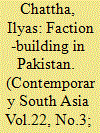

|
|
|
|
|
| Publication |
2014.
|
| Summary/Abstract |
This essay provides new evidence on local Pakistani politics in the immediate post-independence period. It reveals that far from being a period of national unity and service to the fledgling state, the country was mired in faction-building strategies between political rivals, competing for power and scrambling for resources, with debilitating consequences for democratic consolidation. While the new sources - largely based upon the archival records deposited at the National Documentation Centre, Islamabad - provide material relating primarily to Punjab, this essay demonstrates that the tensions between central government and the provinces can only be comprehended by reference to studies of localities.
|
|
|
|
|
|
|
|
|
|
|
|
|
|
|
|
| 6 |
ID:
117629
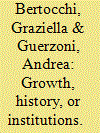

|
|
|
|
|
| Publication |
2012.
|
| Summary/Abstract |
This article explores the empirical determinants of state fragility in sub-Saharan Africa over the 1992-2007 period. Our dataset includes those sub-Saharan countries for which we have information on the distribution by quintiles of the World Bank Country Policy and Institutional Assessment (CPIA) ratings. We evaluate the potential influence on fragility of a wide range of economic, institutional, and historical variables. Among economic factors, we consider per-capita GDP, both in levels and growth rates, investment, natural resources, and schooling. We also consider economic policy variables such as government expenditures, trade openness, and inflation. Demographic forces are accounted for through the fertility rate, life expectancy, and the youth bulge. Institutional factors are captured by measures of ethnic fractionalization, civil liberties, revolutions, and conflicts, as well as governance indicators. Moreover, we select historical variables that reflect the colonial experience of the region, namely the national identity of the colonizers and the political status during the colonial period. Finally, we account for geographic factors such as latitude, access to sea, and the presence of fragile neighbors. Our central findings is that institutions are the main determinants of fragility: even after controlling for reverse causality and omitted variable bias, the probability for a country to be fragile increases with restrictions of civil liberties and with the number of revolutions. Before controlling for endogeneity, economic factors such as per-capita GDP growth and investment show some explanatory power, but economic prosperity displays a contradictory net impact since growth reduces fragility while investment facilitates it. Moreover, instrumental variables estimates show that per-capita GDP growth is no longer a significant factor. Colonial variables display a marginal residual influence: after controlling for all other factors former colonies are actually associated with a lower probability of being fragile.
|
|
|
|
|
|
|
|
|
|
|
|
|
|
|
|
| 7 |
ID:
131420
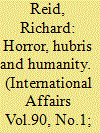

|
|
|
|
|
| Publication |
2014.
|
| Summary/Abstract |
This article examines the international engagement with Africa from the First World War and the apex of colonial rule through to the present day. It is argued that there have been dramatic shifts throughout this period-from increasing interventionism on the part of the colonial state, to decolonization and the emergence of nation-states with independent foreign policy programmes, to the predations and influences of the Cold War, to the developmentalism and humanitarianism of the contemporary era. Yet, there has also been marked continuity in terms of policy, perception and practice. In particular, Africa has long been seen in terms of economic opportunity-a place where markets and raw materials abound-and of military and political threat, a place in which intrinsic instability makes external intervention both desirable and inevitable. While immediate contexts have changed over time, the international engagement with the continent remains essentially economic and military. A concern for democratization and development represents a relatively new element, although even this can be traced to the paternalistic humanitarianism of the colonial era and, earlier still, moral stances toward Africa in the nineteenth century.
|
|
|
|
|
|
|
|
|
|
|
|
|
|
|
|
| 8 |
ID:
128144


|
|
|
|
|
| Publication |
2014.
|
| Summary/Abstract |
This paper attempt to offer insights into the complexity of what can be broadly termed as the South African Indian (SAI) identity through a study of their unique historical trajectory and experiences in the context of the apartheid era, that began in 1948, and the post apartheid phase. Since the dismantlement of the racist regime and first democratic elections in 1994, the SAI community is at across road.
|
|
|
|
|
|
|
|
|
|
|
|
|
|
|
|
| 9 |
ID:
133909
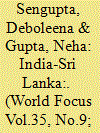

|
|
|
|
|
| Publication |
2014.
|
| Summary/Abstract |
India and Sri Lanka, the two very close neighbours, are separated by a narrow stretch of water called Palk Strait. The history and mythology of the two countries are inter- related and the social ties between the two is more than 2,500 years old and both sides have built upon a legacy of intellectual, cultural, religious and linguistic intercourse. Shortly following independence, the major tribulations bedevilling the rapport of both the countries were the question of citizenship of the persons of Indian Origin resident in Sri Lanka, the majority of who had migrated to the Island during the British Period to the Coffee and subsequently tea plantations.
|
|
|
|
|
|
|
|
|
|
|
|
|
|
|
|
| 10 |
ID:
178159
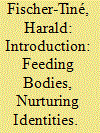

|
|
|
|
|
| Summary/Abstract |
This introductory essay provides an overview of the main subfields of research into the histories of foodstuffs, diet and nutrition in nineteenth- and twentieth-century South Asia, thus situating the contributions to this themed special section in wider historiographical debates and controversies. It argues that the bulk of existing research has focused either on the conflictual role of food and diet in the colonial encounter, or on the emergence of nutritional sciences in India (and in the countries providing food aid to India) during the post-colonial phase in response to the protracted recurrence of food scarcity in the subcontinent. It subsequently identifies a research lacuna by pointing to the conspicuous absence of historical studies on Dalits and food in spite of the topic’s obvious relevance for the creation and maintenance of social hierarchies. The article ends with short previews of the individual essays assembled in this collection.
|
|
|
|
|
|
|
|
|
|
|
|
|
|
|
|
| 11 |
ID:
131021
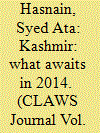

|
|
|
|
|
| Publication |
2014.
|
| Summary/Abstract |
Kashmir was some years ago perceived as an open and shut case where terrorism needed to be swamped and all would return to normal. That usually is a perception which prevails about most internal conflict situations when they are at the peak of conflict progression in terms of ?ghting and other military related activities. Solutions are seldom looked at comprehensively as militaries get self-obsessed with controlling the quantum of violence. Their goals usually remain limited to the subjugation of violence and creation of the much sought after threshold from \\-'here a political process can proceed. That can happen in internal conflicts which are stand-alone and where linkages are limited. In the case of Kashmir, it is questionable whether the con?ict is internal in nature at all because of the deep-set up for linkages which extend to our neighbourhood
|
|
|
|
|
|
|
|
|
|
|
|
|
|
|
|
| 12 |
ID:
132405
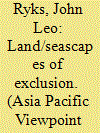

|
|
|
|
|
| Publication |
2014.
|
| Summary/Abstract |
This paper describes how the transformation of coastal New Zealand is directly connected to the dislocation and marginalisation of many M?ori coastal communities. It focuses on how this transformation is played out in text and talk and how certain types of boundaries function as important determinants in the construction and social order of coastal New Zealand. The high value and demand placed on specific, accessible 'cadastral' parcels of private coastal property dictates that much of New Zealand's coast is mapped according to constructs of wealth and desirability. In other parts of the country where development pressures on the coast are less prevalent, coastal communities are less evidently connected to markers of affluence and/or 'whiteness'. In these less disciplined spaces, uncertainty and liminality is more influential in the making of coastal places. Through an analysis of interviews with coastal planners and residents of coastal communities it is revealed that particular hegemonies, through the discourses they produce, attempt to assert a particular socio-spatial epistemology on counter-hegemonic groups in an effort to develop and manage the coast. Communities that revealed an alternative social ordering are described as messy and difficult to manage, while other coastal communities are marketed as exclusive, where model residents inhabit model places.
|
|
|
|
|
|
|
|
|
|
|
|
|
|
|
|
| 13 |
ID:
133023
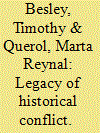

|
|
|
|
|
| Publication |
2014.
|
| Summary/Abstract |
This article exploits variation between and within countries to examine the legacy of recorded conflicts in Africa in the precolonial period between 1400 and 1700. There are three main findings. First, we show that historical conflict is correlated with a greater prevalence of postcolonial conflict. Second, historical conflict is correlated with lower levels of trust, a stronger sense of ethnic identity, and a weaker sense of national identity across countries. Third, historical conflict is negatively correlated with subsequent patterns of development looking at the pattern across grid cells within countries.
|
|
|
|
|
|
|
|
|
|
|
|
|
|
|
|
| 14 |
ID:
134147


|
|
|
|
|
| Publication |
2014.
|
| Summary/Abstract |
This article contributes to the existing critical theory and gender scholarship on private military security companies by examining how the gendered subjectivities of third-country nationals (TCNs) are constituted through the intersections of colonial histories and neoliberal economic practices. Focusing on Gurkha contractors, I ask how it is that both the remuneration and the working conditions of TCNs are inferior to those of their white Western peers within the industry. The article shows that Gurkhas' working conditions flow from their location on the periphery of global employment markets, a disadvantage that is further inflected by their status as racially underdeveloped subjects. Thus, their material and cultural status within the industry - regardless of the abilities of the individuals in question - is argued to be the outcome of tenacious colonial histories that continue to shape the labour-market opportunities of men from the global South within larger global security governance practices that increasingly feature outsourcing of military labour in operations.
|
|
|
|
|
|
|
|
|
|
|
|
|
|
|
|
| 15 |
ID:
129849
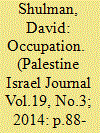

|
|
|
|
|
| Publication |
2014.
|
| Summary/Abstract |
The phrase "Obstacles to successful negotiation" has a somewhat distant ring to it. I was a little taken aback when I first read it. It's an abstraction, and far too hopeful at that. Obstacles could in theory, be removed. Maybe someday they will be. But, for now, anyone who knows the reality of what is happening on the ground in the south Herbon Hills isn't likely to think in terms of obstacles.
|
|
|
|
|
|
|
|
|
|
|
|
|
|
|
|
| 16 |
ID:
132870
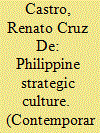

|
|
|
|
|
| Publication |
2014.
|
| Summary/Abstract |
Japan has shown three distinct strategic cultures since its emergence as a modern state in the 19th century: isolationist and non-military, militarist, and post-World War II strategic culture characterized by great reluctance to use military power abroad, even in collective self-defence. This article examines Japan's strategic culture and the potential for a fourth distinct strategic culture through the broader framework of security identity, arguing that this is evolving but has not changed as much as one might expect due to institutionalized antimilitarism and political support for the security practices it has engendered. Contemporary Japanese strategic culture can be understood through debates over recent Japanese security policy as well as actual changes in security practice. Domestic politics and a changing international environment are likely to lead Japan to a somewhat more active military role in the near term, but an analysis based on the dynamics of Japan's dominant security identity suggests that its strategic culture will continue to show a reluctance to use or develop military power beyond very limited scenarios, despite vocal efforts by some political actors to increase military activity abroad.
|
|
|
|
|
|
|
|
|
|
|
|
|
|
|
|
| 17 |
ID:
131913
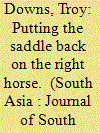

|
|
|
|
|
| Publication |
2014.
|
| Summary/Abstract |
Standard historical accounts of the Indian Revolt of 1857-58 give the impression that superiority on the battlefield accounted for the ability of the British to defeat their Indian adversaries. Yet, to focus solely on the military campaigns ignores the intricate and multifaceted nature of the British response to the Revolt. Aside from armed force, a number of counter-insurgency strategies were used to suppress rebellion in the countryside. This paper assesses the intent and effectiveness of these measures by looking at how officials responded to the outbreak of large-scale and protracted rural insurgency in the districts of the Benares Division. It is argued that these measures achieved a far greater degree of success in curtailing acts of rural insurgency than the use of military force.
|
|
|
|
|
|
|
|
|
|
|
|
|
|
|
|
| 18 |
ID:
132346
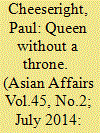

|
|
|
|
|
| Publication |
2014.
|
| Summary/Abstract |
The climax of the battle of Kohima was in June 1944, 70 years ago. This article is about the part played in that victory by Ursula Graham Bower, an English woman subsequently honoured by the RSAA. She led a team of Naga tribesmen from North East India who acted as intelligence scouts, feeding the 14th Army with information about the Japanese, acting as guides for British units and providing a security network against spies. Graham Bower was effective because she had lived amongst the Nagas before the war and gained their trust. Inevitably she was glamourised in the media and hailed as the Jungle Queen or the Naga Queen, a Western beauty fighting against the Japanese. In reality, with the Nagas, she performed a intelligence role, not a fighting role, but it was a vital contribution to victory.
|
|
|
|
|
|
|
|
|
|
|
|
|
|
|
|
| 19 |
ID:
128508
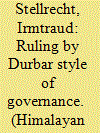

|
|
|
|
|
| Publication |
2013.
|
| Summary/Abstract |
In May 2009, in a small chat room in the Hunza Valley (in Northern Areas of Pakistan), a heated debate ?ared up over an old photograph. It showed Mir Muhammad Nazim Khan, ruler of Hunza State, from 1892
to 1938, and his Wazir, Humayun Beg, in ceremonial attire at the Imperial Coronation Durbar at Delhi in 1903. The opinions offered by the participants ranged from appreciation for great leaders of the past to their
utter condemnation as colonial 'devils' and exploiters. In fact, the photo conveys various messages. For me, first of all, it shows the integration of the Hunza Mir into a colonial hierarchy. Second, and more generally
speaking, it draws our attention to the world of durbars or 'ceremonial gatherings' in colonial India. Muhammad Nazim Khan was actively involved in this world.' He participated in two imperial durbars at Delhi, and every year he also attended a durbar, known as the Ialsa.
|
|
|
|
|
|
|
|
|
|
|
|
|
|
|
|
| 20 |
ID:
132967
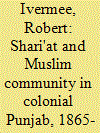

|
|
|
|
|
| Publication |
2014.
|
| Summary/Abstract |
This paper argues that concerns for the government appointment of qazis, officers for the administration of Muslim law, and the greater application of shari'at critically shaped Muslim community formation in later nineteenth century Punjab. Between 1865 and 1885, Punjabi Muslim elites attested the necessity of qazis being appointed by government and Muslim law being administered in the colonial judicial system. With the support of Gottlieb Leitner, registrar of the Punjab University College, Muslim parties used the emergent associations of Punjab civil society, including the Anjuman-i-Punjab (Lahore) and Anjuman-i-Islam (Lahore), to assert the indispensability of religious law. In doing so, they challenged the Anglo-Indian decision to prioritize customary law in the Punjab and advanced the religious group as the basic social unit of Punjab society. In Punjab public spaces, the relevance of Islam was proclaimed, challenging the professed Anglo-Indian distinction between private and public, religious and secular spheres. However, demands for qazi appointment and the administration of shari'at problematize well-rehearsed arguments about the relationships between family, community, state and religion in colonial Punjab. Only through an enquiry into the two decades after 1865 may later political campaigns for the application of shari'at be understood.
|
|
|
|
|
|
|
|
|
|
|
|
|
|
|
|
|
|
|
|
|